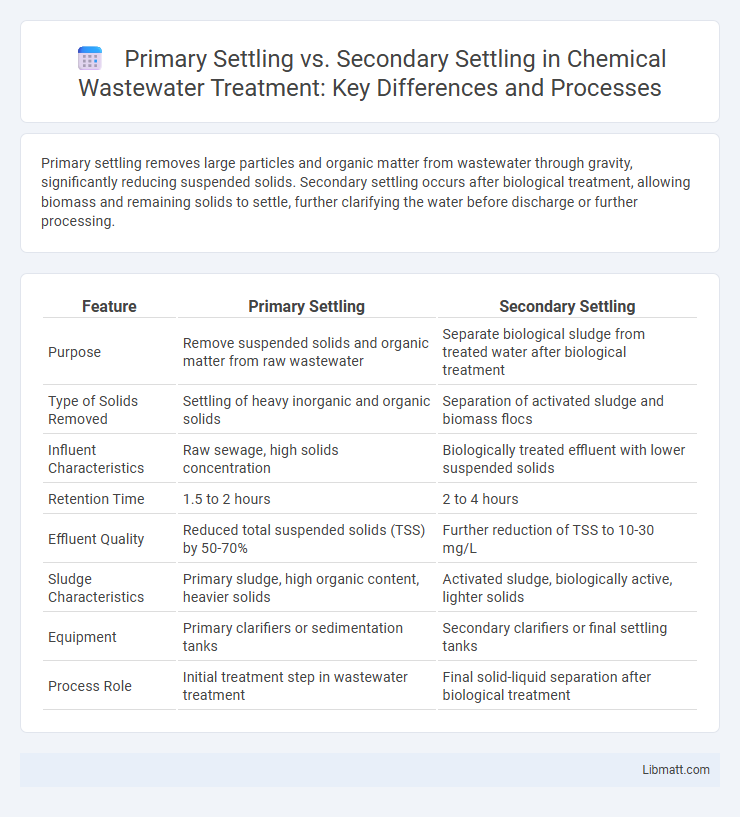Primary settling removes large particles and organic matter from wastewater through gravity, significantly reducing suspended solids. Secondary settling occurs after biological treatment, allowing biomass and remaining solids to settle, further clarifying the water before discharge or further processing.
Table of Comparison
| Feature | Primary Settling | Secondary Settling |
|---|---|---|
| Purpose | Remove suspended solids and organic matter from raw wastewater | Separate biological sludge from treated water after biological treatment |
| Type of Solids Removed | Settling of heavy inorganic and organic solids | Separation of activated sludge and biomass flocs |
| Influent Characteristics | Raw sewage, high solids concentration | Biologically treated effluent with lower suspended solids |
| Retention Time | 1.5 to 2 hours | 2 to 4 hours |
| Effluent Quality | Reduced total suspended solids (TSS) by 50-70% | Further reduction of TSS to 10-30 mg/L |
| Sludge Characteristics | Primary sludge, high organic content, heavier solids | Activated sludge, biologically active, lighter solids |
| Equipment | Primary clarifiers or sedimentation tanks | Secondary clarifiers or final settling tanks |
| Process Role | Initial treatment step in wastewater treatment | Final solid-liquid separation after biological treatment |
Introduction to Wastewater Settling Processes
Primary settling removes heavy solids and organic matter from wastewater using gravity in primary clarifiers, significantly reducing suspended solids and biochemical oxygen demand (BOD). Secondary settling follows biological treatment, allowing activated sludge and microbial flocs to settle, thereby clarifying treated water before discharge or further processing. Understanding the differences between primary and secondary settling optimizes your wastewater treatment efficiency and environmental compliance.
Overview of Primary Settling
Primary settling involves the removal of suspended solids and organic matter from wastewater by gravity sedimentation in primary clarifiers, capturing settleable solids as sludge. This process reduces the load on secondary treatment by significantly decreasing total suspended solids (TSS) and biochemical oxygen demand (BOD). Effective primary settling enhances overall treatment efficiency by improving downstream aerobic biological processes.
Overview of Secondary Settling
Secondary settling tanks, also known as final clarifiers, play a crucial role in wastewater treatment by separating activated sludge from treated water after biological treatment. These tanks improve water clarity and quality by allowing biomass to settle, ensuring that your effluent meets environmental discharge standards. Efficient secondary settling enhances overall plant performance by reducing suspended solids and preventing sludge carryover.
Key Differences Between Primary and Secondary Settling
Primary settling involves the removal of settleable solids and organic matter from raw sewage through sedimentation, primarily in primary clarifiers. Secondary settling occurs after biological treatment, where biomass flocs and suspended solids are separated in secondary clarifiers to clarify the treated effluent. Key differences include the nature of solids removed--primary settling targets raw sludge and grit, while secondary settling focuses on biological flocs--and the impact on overall treatment efficiency and effluent quality.
Mechanisms of Solids Removal
Primary settling removes solids primarily through gravitational sedimentation, allowing heavier suspended particles to settle at the bottom of the tank as sludge. Secondary settling relies on biological flocculation and sedimentation, where microbial biomass aggregates into flocs that settle more slowly than primary solids. The efficiency of primary settling targets total suspended solids, while secondary settling focuses on separating activated sludge from treated effluent.
Role in Wastewater Treatment Workflow
Primary settling plays a crucial role in wastewater treatment by removing heavy solids and organic matter through sedimentation before biological treatment. Secondary settling follows biological treatment, separating treated sludge from clarified water to ensure high-quality effluent discharge. Your wastewater treatment system relies on both stages to optimize contaminant removal and maintain process efficiency.
Efficiency and Performance Comparison
Primary settling tanks achieve efficiency by removing 50-70% of suspended solids through gravity sedimentation, effectively reducing the load on secondary treatment. Secondary settling tanks improve performance by targeting biological flocs and remaining suspended solids, achieving over 90% removal efficiency for BOD and suspended solids. The combined operation enhances overall wastewater treatment by optimizing solids removal at different stages, ensuring stable effluent quality and better downstream processing.
Common Design Features of Settling Tanks
Primary settling tanks typically feature rectangular or circular basins designed for the removal of settleable solids from raw wastewater, with slower flow velocities to promote sedimentation. Secondary settling tanks are usually larger, equipped with mechanisms like scrapers or return activated sludge systems to separate biological flocs formed during secondary treatment. Your wastewater treatment system benefits from these tanks' common design elements, such as weirs for uniform flow distribution and sludge hoppers for efficient solids collection.
Operational Challenges and Solutions
Primary settling faces operational challenges such as high sludge volume and the presence of grease and grit, which can cause clogging and settling inefficiencies; solutions include regular desludging, grit removal systems, and maintaining optimal detention times. Secondary settling encounters challenges like sludge bulking and rising sludge, often caused by filamentous bacteria growth or hydraulic overload; these issues can be mitigated through improved sludge age control, proper aeration, and periodic sludge wasting. Both units require real-time monitoring systems and automated controls to optimize performance and reduce operational disruptions.
Conclusion and Best Practices
Primary settling targets the removal of large solids and organic matter early in wastewater treatment, while secondary settling focuses on separating biological flocs from the treated water. Best practices recommend optimizing detention times and sludge withdrawal rates in both stages to enhance efficiency and prevent carryover of solids. You should monitor and adjust operational parameters regularly to maintain optimal performance and compliance with discharge standards.
primary settling vs secondary settling Infographic

 libmatt.com
libmatt.com